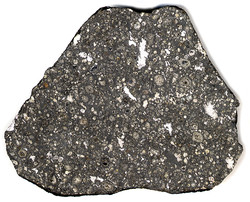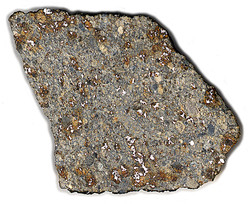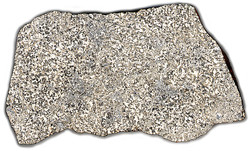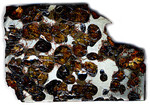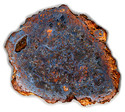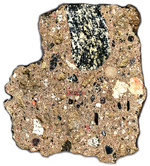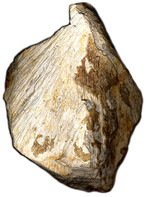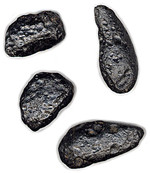Meteorites are fragments of other worlds that have survived the entry into the Earth's atmosphere. Most meteorites originate in the asteroid belt from bodies that formed very early in the history of the solar system. Almost all of the information we have learned about the solar system, such as its age, history, and chemical composition, is due to the detailed study of meteorites. From the point of view of origin, there are three basic types of meteorites: Stony, Stony-Iron, and Iron. In this exercise I have broken down the Stony class into three sub-classes: Carbonaceous Chondrites, Ordinary Chondrites, and Achondrites. Meteoriticists recognize many more classes of meteorites and have reconstructed a marvelously detailed history of the solar system from their subtle differences.
An especially important type of meteorite is the carbonaceous chondrite, a specific type of stony meteorite that originates from primitive asteroids. In this context, primitive means that the asteroid has been altered very little over the age of the solar system. More specifically, it means that the asteroid has not been heated to the point that would change the material that makes up the asteroid.
Carbonaceous Chondrite Meteorites are black to dark gray in color, rich in the element carbon (thus their black color), and contain small spherical droplet-like inclusions called chondrules. They are among the most primitive objects in the solar system, having survived almost unchanged for 4.6 billion years. Carbonaceous chondrites were the first place amino acids were found outside of the Earth, and it has been recently learned that some of the materials in these meteorites were formed outside of our solar system before our solar system was even formed, so they are not only an important probe into our early solar system history, but they may supply us with samples of materials from beyond our solar system.
Carbonaceous chondrites are rare among meteorites that fall to the Earth (~ 4%). Added to the fact that they look enough like Earth rocks, means that they are very rare in collections. They also weather very easily and do not survive long on the surface of the Earth. [This image shows a slice of a type of carbonaceous chondrite meteorite that fell to the Earth in Allende, Mexico, on February 9, 1969.]
Ordinary chondrites are the most common meteorites that fall to Earth (~ 74%). Since they tend to have a similar appearance and density as Earth rocks, stony meteorites are difficult to recognize in the field. Unless someone sees them fall, they usually go uncollected. Therefore, although ordinary chondrites are the most common type out in space, they are more rare than iron meteorites in collections on Earth.
Ordinary chondrites show a wide variety of appearances: some light, some dark, some coarse grained, some fine--grained. As their name implies, ordinary chondrites contain chondrules. However, the chondrules in ordinary chondrites are never as distinct as the ones in carbonaceous chondrites. This is a nice indication that ordinary chondrites have been heated to a higher temperature than carbonaceous chondrites, and are therefore less primitive. Almost all ordinary chondrites contain some metallic iron, you can see the iron as bright metallic flakes throughout the sample. Since the rock and iron are well mixed, this implies that the object that the ordinary chondrite came from never differentiated.
Most ordinary chondrites are from the outer parts of an asteroid that suffered destruction by collision. Since ordinary chondrites are the most common meteorite on the Earth, this implies that they represent the most common material in the asteroid belt. Since ordinary chondrites come from bodies that that not been heated very much, this means they come from object that were never very large. This implies that most of the objects in the asteroid belt were never very large. [This image shows a slice of an Ordinary chondrite. This sample fell to the Earth in Homestead, Iowa on February 12, 1876.]
As their name implies, Achondrites are stony meteorites that lack chondrites. Achondrite meteorites account for only about 8% on the meteorites that hit the Earth. The lack of chondrules is a sign that most achondrites meteorites have been subjected to a much greater degree of heating that other stony meteorites. This implies the achondrites came from bodies that have been geologically active in the past. Many achondrites are very similar to terrestrial volcanic material. Some achondrites are pieces of impact breccia, and some are very similar to pristine highland rocks on the Moon.
In general, achondrites are the materials from the surface (or near surface) of a once geologically active surface. All meteorites from Mars and the Moon are achondrites. All rocks on the Earth would be achondrites if they blasted into space and fell back as meteorites. The image on the right is a piece of the Millbillillie achondrite. It is a piece of basalt from a formerly geologically active surface.
Stony-Iron meteorites are the rarest class of meteorites, comprising only about 1% of meteorites that fall to Earth. There are two broad classes of stony-iron meteorites: Pallasites (composed primarily of iron with crystals of a rock mineral called olivine embedded in it) and mesosiderites (that look like stony meteorites with lots of metallic iron veins running through them).
Pallasites are thought to be material from the boundary zone between the iron cores and the stony outer mantles of the now-destroyed asteroids, while mesosiderites are theorized to be formed when an impact on an asteroid mixes material from the rocky mantle with iron from the core. The image on the left shows a polished slice of a pallasite stony-iron meteorite. The dark roundish inclusions are the rocky mineral olivine, and the lighter surrounding material is metallic iron. This sample is from the Brenham meteorite crater in Kansas. The image on the right is a mesosiderite meteorite from the Dalgaranga meteorite crater in Western Australia. The sample has been heavily weathered. The grey veins of metallic iron and the brown areas of rock are intimately mixed.
Iron meteorites are the most easily recognizable meteorites. Since even a casual examination shows that they are not ordinary rocks, they tend to be very common in collections although they are rare in space (~5% of all meteorites). They are very dense and, except for a thin crust (made by the melting of the skin during the passage through the atmosphere), they look and feel like metal. Chemically, they are composed mostly of iron with a few percent nickel and a little cobalt.
When sawed in half, polished, and etched, they display a geometrical pattern called a Widmanstatten pattern (see figure). This pattern is actually crystals of iron and nickel that form as the result of the meteorite having cooled very slowly (about 1 degree C per million years) under very high pressure. The existence of the Widmanstatten pattern is our best evidence that iron meteorites were once the cores of larger, differentiated bodies. Buried deep in a body, the mass of the overlying rocks provide the high pressure and the insulation for slow cooling. The image on the left shows a polished and etched cross--section of an iron meteorite from the Henbury impact craters in Australia.
When a large meteorite strikes the Earth, the kinetic energy of the meteorite is converted into thermal, mechanical, and acoustic energy that creates a shockwave that passes through the ground and distorts, fractures, and ejects pieces of the target. This modified target material is often all that remains of a crater after millions of years of geological activity. Therefore, the recognition of this material plays an important role in understanding impact events. The most common types of impact--modified material we will see are: impact breccia, shatter cones, and tektites.
Impact breccias form when a crater--forming meteorite shatters, pulverizes, and melts the target material. They are composed of rock and mineral fragments embedded in a matrix of fine--grained material. The fragments are usually sharp and angular, and vary greatly in size and shape. The composition of the fragments depends on the target material. Impact breccias often have the appearance of poorly mixed concrete (see figure). On airless, impact--covered worlds like the Moon, impact breccias are a very common type of rock. The most common type of sample returned by the Apollo lunar mission was impact breccia. Unfortunately, rocks that look a lot like impact breccias can be formed by volcanic and tectonic processes, so finding a breccia is not always a clear indication of an impact event. [This images shows a piece of impact breccia from the Ries crater in Germany.]
Shatter cones form when the shockwave from a meteorite impact event passes through the target rocks and modifies them. The resulting rocks have distinctive, curved, striated fractures that typically form partial to complete cones [see figure]. Shatter cones can form in all types of target rocks. The better--looking shatter cones form in very fine--grained rocks like sandstones. They can range in size from centimeters to many tens of meters. Shatter cones are now accepted as a unique identifier of a meteorite impact event. This means that if you find a shatter cone, you have found a place where a meteorite has hit. Since the Earth is such an dynamic world, it will erase impact craters over a relatively short time period. Often, shatter cones are all that is left to identify an impact crater. An interesting feature of shatter cones is that the tips point toward the origin of the shockwave. This means that you can use shatter cones to reconstruct the size and shape of ancient impact craters that have subsequently been modified by other processes. [This image shows a shatter cone from the Steinheim Basin in Germany.]
Tektites have been controversial objects since their discovery, with both their origin and source being a subject of hot debate for more than a century. Tektites are small, glassy objects with shapes like spheres, ellipsoids, dumbbells, and other forms characteristics of isolated molten blobs. They are typically black, but can be brown, gray, or even green. Tektites look a lot like volcanic glass (e.g., obsidian) but are chemically distinct. The most telling chemical difference is that unlike volcanic glasses, tektites contain virtually no water. Current scientific consensus is that tektites are terrestrial material that has been melted and ejected from an impact event. Their shape is derived from cooling, aerodynamically, during flight from the impact. Tektites are fairly common all over the Earth. (You can almost always find them for sale in "New Age" crystal shops.) However, linking them with particular impact events has proven problematic. When exactly the tektites are formed during an impact event, and why they are found at only a few craters are two of the more obvious problems that have yet to be satisfactorily solved. [This image shows a collection of tektites from Thailand.]
